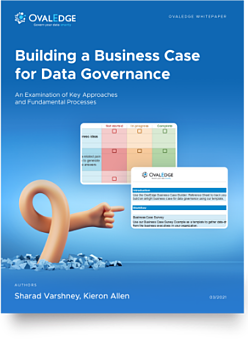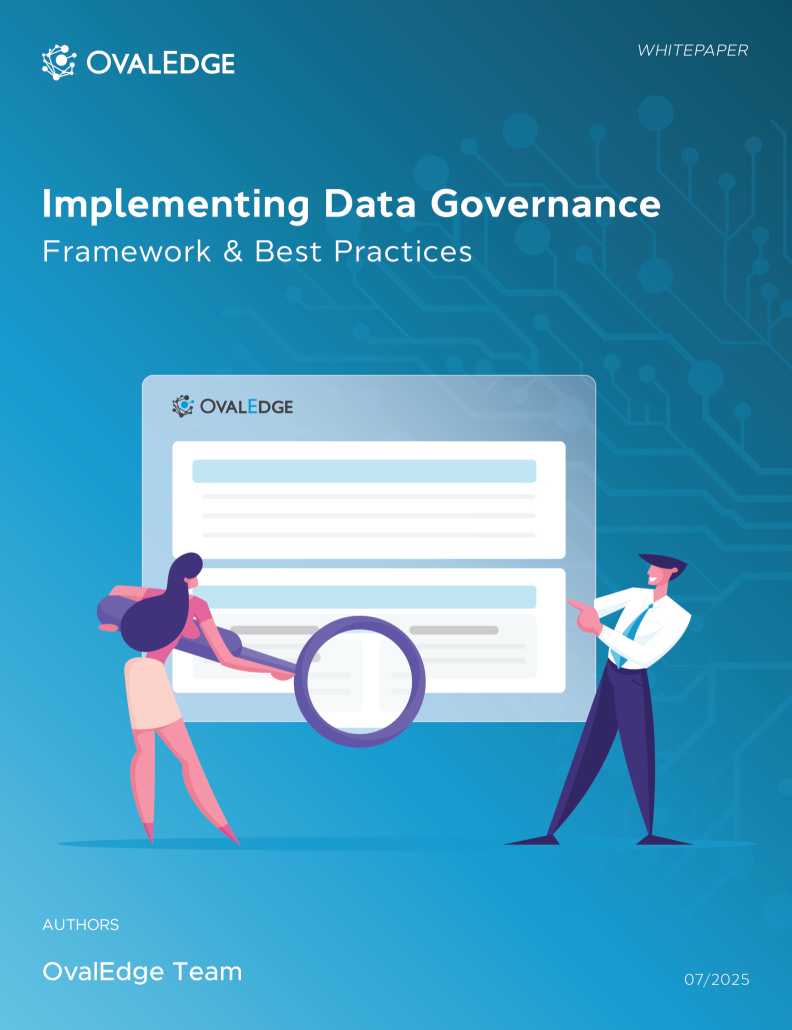Table of Contents
What is Data Fabric? Definition & Architecture
With the increased importance of data to businesses, it’s no surprise that there are more and more ways to organize and store data.
From local network storage to the cloud, to data lakes, you’re spoiled for choice!
But as companies strive to be more competitive, efficient, and profitable, these growing and disparate data sources can become increasingly problematic.
You’ll often end up with huge amounts of data, split across different locations, apps, and formats. This, combined with rapidly increasing regulatory pressure, can create more problems than it solves.
The solution isn’t to create yet another way to store data, but to find a way to bring all of this data together in a manageable way.
Which is exactly what Data Fabric does!
Are you ready to create a sturdy case for the ROI of a data governance program? Download OvalEdge Use Cases
What is Data Fabric?
Data Fabric is an architectural approach that enables organizations to break down data silos and ensure all data is governed, accessible, and secure. In simple terms, the data fabric definition refers to a framework that integrates all your data systems, allowing seamless data management and analytics.
It gives companies access to all of their data, across data warehouses, data lakes, relational databases, and SaaS applications, plus anywhere else they have data stored.
This is achieved using a virtualization layer to aggregate access, then utilizing robust data integration tools to create a data catalog.
This catalog can then be used by business analysts, data scientists, app developers, and more to efficiently and securely carry out their work.
An easy way to understand the data fabric meaning is to imagine it like WhatsApp chats. Before, you had a bunch of individual chats, and it was difficult and time-consuming to talk to everyone separately.
Data Fabric is like a group chat that brings everyone together, making it easy to keep track of what’s going on and communicate with everyone at once.
Related: How to Build a Data Catalog
Why use Data Fabric?
International Data Corporation, a global market intelligence firm, reports that 83% of CEO's want their organization to be more data-driven and are investing in growing their Data Cultures.
But there is a huge difference between calling yourself data-driven and actually utilizing data to grow and plan for the future.
So, what is data fabric used for?
Data Fabric provides a blueprint to help organizations leverage their data and get the most out of their data-driven initiatives. It helps organizations create a unified data environment, where data can be accessed, manipulated, and analyzed from multiple sources in a secure and compliant manner.
It also provides the infrastructure to enable teams to develop and deploy predictive models quickly and cost-effectively.
Another huge pressure on companies is compliance with regulations like GDPR, CCPA, HIPAA, and FCRA. These specific regulations may not apply to everyone, but every company has its own regulations to adhere to, and the more data you have, the harder this becomes.
The Data Fabric architecture makes this much simpler, as you can access all your data inside the data catalog and monitor for breaches and compliance risks.
To achieve this, it uses active metadata to automate policy enforcement, mask/redact data, and create role-based access control (RBAC).
This means organizations can meet their data governance and privacy requirements while also allowing them to take advantage of the latest data-driven technologies.
Related: 3 Data Privacy Compliance Challenges that can be solved with OvalEdge
How Does a Data Fabric Work?
To understand how data fabric works, imagine your business data as ingredients scattered across multiple kitchens.
The finance team has grains, marketing has spices, and sales keeps the vegetables.
When you need to cook a complete meal (or generate business insight), you have to visit each kitchen, time-consuming, right?
Data fabric acts like a smart chef who knows where every ingredient is, connects all kitchens, and gives you one dashboard to use everything efficiently.
Here’s how it actually functions:
- Data Integration: It connects various sources from databases and APIs to cloud tools without physically moving the data.
- Data Virtualization: Instead of copying data into one system, it creates a unified virtual view of all data in real time.
- Metadata Management: Data fabric uses active metadata to track where data comes from, who uses it, and how it changes.
- Automation and AI: AI helps clean, classify, and govern data automatically, improving accuracy and reducing manual work.
- Access and Governance:
It enforces security rules, giving the right access to the right people while maintaining compliance.
In essence, data fabric builds a connected ecosystem where your data is always available, organized, and trustworthy.
Data Fabric Benefits
Security
Data Fabric provides robust security for data, with access control, data masking, and encryption. This helps organizations meet their compliance requirements and protect sensitive data.
It also helps reduce the risk of data breaches and gives organizations more control over who has access to their data.
Integration
Data Fabric simplifies the process of data integration, making it more efficient for organizations to access data from multiple sources and build a unified data environment. With this integrated approach, organizations can quickly and easily aggregate data from different sources and get more value from their data.
This allows for a greater range of insights to be derived from the data, making it easier to make informed decisions and stay ahead of the competition. Furthermore, the single unified data environment ensures that all data is kept secure and organized, allowing for more effective data management.
Better understanding of the data
Implementing a Data Fabric architecture helps organizations better understand their data. By having access to all their data in one place, it is much easier to analyze, identify patterns, and gain insights.
It also allows organizations to compare different data sources to better understand how the data is being used and how it is changing over time.
This makes it easier to spot problems and opportunities, and to make informed decisions based on the data.
Governance
As we’ve already touched on, Data Fabric provides the governance needed to ensure that data is handled in a compliant manner. It uses active metadata to automate policy enforcement, mask/redact data, and create role-based access control (RBAC).
This helps organizations to meet their data governance and privacy requirements, and allows them to take advantage of the latest data-driven technologies.
This also provides the infrastructure to monitor for breaches and compliance risks, making it easier to stay on top of data security.
Related: Top 5 Data Governance Use Cases
AI
A term thrown around so much it’s often discarded as a buzzword, AI is very much here to stay, and there is one thing all AI needs…
Data!
Data Fabric makes it easy for organizations to take advantage of AI and machine learning. By providing a single source of data, it eliminates the need to search through disparate data sources and makes it easier to find the data you need for your models.
Plus, the active metadata and security features provided by Data Fabric tools make it easier to ensure data is handled by AI in a compliant way, and reduce the risk of data breaches.
Best practices for implementing Data Fabric
Solid governance
If it’s not already clear, data governance is at the heart of Data Fabric, and you need to take it seriously to get the benefits. This includes things like:
- Organizing all your data sources and consolidating your data into a single location.
- Ensuring that all data adheres to data privacy regulations and internal company policies.
- Once you have organized your data, you need to figure out how to show it to your team.
- Use methods and technologies to ensure data is secure and well-managed
- Ensure people can only access the data they’re permitted to access
Discoverability
Data Fabric also needs to enable discoverability. This means making sure that users can easily find the data they need, and that the data is up to date and accurate.
To achieve this, organizations should leverage metadata, data cataloging, and search tools to ensure users quickly find the data they need.
Use a self-service platform (like OvalEdge)
We’ve covered what Data Fabric is, why you should use it, and what the benefits are, but we need to be clear. Data Fabric is an architecture, and can’t be achieved without tools that make it possible.
This is where self-service platforms come in!
Self-service platform tools like OvalEdge help organizations to quickly and easily implement the Data Fabric architecture.
These tools provide a unified platform to easily access and integrate data from multiple sources, while also providing data governance and security features. This makes it easier to ensure that data is managed in a compliant and secure manner, while allowing users to quickly access the data they need.
Data Fabric vs Data Mesh
Along with Data Fabric, Data Mesh is another approach that’s gaining popularity. There’s often confusion about the difference between data fabric and data mesh.
The easiest way to differentiate the two:
- Data Fabric focuses on integrating and connecting technologies that support data management.
- Data Mesh focuses on the people and processes behind data management.
Essentially, Data Fabric is the foundation that makes it possible for domain owners to access and utilize data as part of a Data Mesh.
Our CEO Sharad Varshney was recently asked this very question at a Q&A, and this was his answer:
The easiest way to differentiate between a data fabric and a data mesh is this: A data fabric architecture is centered on integrating and connecting the technologies that support data management, and a data mesh architecture focuses on the people and procedures behind data management.
Both approaches streamline data management by connecting various systems and technologies in a distributed landscape. However, you could say that data fabric architecture effectively underpins a data mesh by providing the flexibility, agility, and connectivity required if domain owners are to support seamless, decentralized data access.
Essentially, the Data Fabric architecture is the foundation that makes it possible for domain owners to access and utilize data as part of a Data Mesh.
FAQs
1. What is the data fabric definition?
It’s an architecture that connects data across multiple platforms, making it accessible, secure, and governed in one unified environment.
2. What does data fabric mean in simple terms?
It’s a framework that brings all your company’s data together—so you can analyze, govern, and use it without worrying about where it’s stored.
3. What is data fabric used for?
It’s used for connecting, managing, and governing data across systems while supporting analytics, AI, and compliance efforts.
4. What is the difference between data fabric and data mesh?
Data Fabric integrates technologies for managing data, while Data Mesh structures how teams organize and own that data.
5. Is Data Fabric the future of data management?
Yes. As companies adopt hybrid and multi-cloud systems, Data Fabric offers the flexibility and intelligence needed to handle data efficiently across environments.
What you should do now
|
OvalEdge recognized as a leader in data governance solutions
.png?width=1081&height=173&name=Forrester%201%20(1).png)
“Reference customers have repeatedly mentioned the great customer service they receive along with the support for their custom requirements, facilitating time to value. OvalEdge fits well with organizations prioritizing business user empowerment within their data governance strategy.”
.png?width=1081&height=241&name=KC%20-%20Logo%201%20(1).png)
“Reference customers have repeatedly mentioned the great customer service they receive along with the support for their custom requirements, facilitating time to value. OvalEdge fits well with organizations prioritizing business user empowerment within their data governance strategy.”
Gartner, Magic Quadrant for Data and Analytics Governance Platforms, January 2025
Gartner does not endorse any vendor, product or service depicted in its research publications, and does not advise technology users to select only those vendors with the highest ratings or other designation. Gartner research publications consist of the opinions of Gartner’s research organization and should not be construed as statements of fact. Gartner disclaims all warranties, expressed or implied, with respect to this research, including any warranties of merchantability or fitness for a particular purpose.
GARTNER and MAGIC QUADRANT are registered trademarks of Gartner, Inc. and/or its affiliates in the U.S. and internationally and are used herein with permission. All rights reserved.



.webp)


